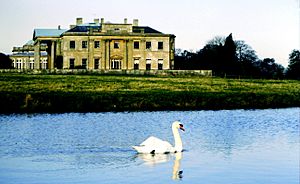Dodington Park facts for kids
Quick facts for kids Dodington Park |
|
|---|---|

Dodington House
|
|
| Location | Dodington, Gloucestershire, England |
| Lua error in Module:Location_map at line 420: attempt to index field 'wikibase' (a nil value). | |
Dodington Park is a large country house and estate located in Dodington, South Gloucestershire, England. The house was designed by the famous architect James Wyatt for Christopher Bethell Codrington. The Codrington family became very wealthy from their large sugar farms in the Caribbean, where enslaved people were forced to work.
The estate stayed in the Codrington family until 1980. Today, it is owned by the British inventor and businessman James Dyson. The property includes about 300 acres of beautiful parkland with woods, lakes, and various buildings. These include a dower house, an orangery, a church, and a walled kitchen garden.
The main house is a Grade I listed building, meaning it is very important historically. The landscaped park is also highly protected as a Grade II* listed site. Many other buildings on the estate, like the dower house, orangery, and St Mary's Church, are also Grade I listed.
Contents
Where is Dodington Park?
Dodington Park is located in the village of Dodington in South Gloucestershire, which is in the South West of England. The estate sits on the western edge of the southern Cotswolds, a beautiful area of hills.
The estate's eastern side is next to the A46 road, which connects the cities of Bath and Stroud. The northern side is bordered by the A432 road, going from Chippenham to Sodbury. A small road connecting Dodington village to the A46 forms the southern boundary.
A Look at Dodington Park's History
The Codrington family first bought the Dodington estate in the late 1500s. At that time, it had a large Elizabethan-style house and a church. In the 1700s, the family became extremely rich from their sugar plantations in the British West Indies. This wealth allowed them to expand and improve the estate.
The park's grounds were first designed around 1764 by the famous landscape architect Capability Brown. Later, in 1793, William Emes and John Webb made some changes to the design.
Building the Main House
The main house was built between 1798 and 1816 by James Wyatt for Christopher Bethell Codrington. It is made from Bath stone and has a slate roof. The house is built in a Roman classical style, and each side looks a little different.
A curved conservatory connects the house to the church, which was also rebuilt by Wyatt. In 1930, a formal garden was added to the property. The inside of the house features beautiful decorative plasterwork by Francis Bernasconi.
Special Features of the Estate
The house was very large, about 52,000 square feet, when it was sold in 2003. A curved glass building called an orangery is located on the west side of the house. It has a black and white stone floor and glass doors that lead directly into the house.
The church of St Mary, which is right next to the house, is also a Grade I listed building. Other important buildings on the estate include the Fishing Lodge, stables, and a barn. Many walls, gates, and bridges around the estate are also listed for their historical importance.
Dodington Park During Wartime
During the Second World War, Betteshanger School moved to Dodington Park for safety. In the 1950s, the Codrington family faced financial challenges in keeping up the large estate. Because of this, Dodington Park was opened to the public.
Visitors could explore the house and grounds. By the 1970s, the estate even had an adventure playground, a carriage museum, and a small railway to attract more people.
Changes in Ownership
The estate was put up for sale in 1983 and sold the following year. The Codrington family's old records, which included details about their history with farming and slavery in the West Indies, were sold in the late 1970s. Dodington Park was also featured on a BBC 2 TV show called Arthur Negus Enjoys in 1981.
Dodington Park Today
In 1983, Sir Simon Codrington sold Dodington Park to Michael Percival Kent, a developer from Bath, who fully restored Dodington including the beautiful St Mary’s Chapel. Percival Kent sold the estate in 1993. The property changed hands twice before the British inventor and businessman James Dyson bought it in 2003 for about £20 million.
In 2011, Mr. Dyson built an underground swimming pool beneath the orangery. Planning officers found out about the pool in 2015, and Mr. Dyson had to apply for permission after it was already built. The permission was granted in October 2016.


